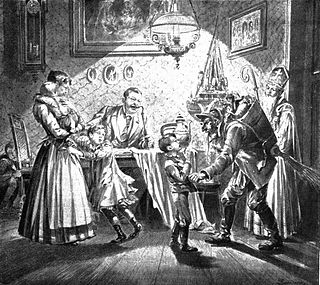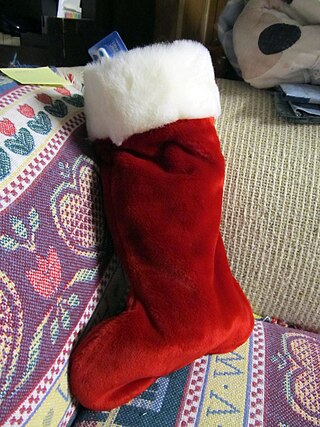
Confectionery is the art of making confections, which are food items that are rich in sugar and carbohydrates. Exact definitions are difficult. In general, however, confectionery is divided into two broad and somewhat overlapping categories: bakers' confections and sugar confections. The occupation of confectioner encompasses the categories of cooking performed by both the French patissier and the confiseur.

The Shrine of the Three Kings, Tomb of the Three Kings, or Tomb of the Three Magi is a reliquary traditionally believed to contain the bones of the Biblical Magi, also known as the Three Kings or the Three Wise Men. This shrine is a large gilded and decorated triple sarcophagus situated above and behind the high altar of Cologne Cathedral in western Germany. Built approximately from 1180 to 1225, it is considered the high point of Mosan art by various historians and scholars, and ranks amongst the largest reliquary in the Western world.

The companions of Saint Nicholas are a group of closely related figures who accompany Saint Nicholas throughout the territories formerly in the Holy Roman Empire or the countries that it influenced culturally. These characters act as a foil to the benevolent Christmas gift-bringer, threatening to thrash or abduct disobedient children. Jacob Grimm associated this character with the pre-Christian house spirit which could be benevolent or malicious, but whose mischievous side was emphasized after Christianization. The association of the Christmas gift-bringer with elves has parallels in English and Scandinavian folklore, and is ultimately and remotely connected to the Christmas elf in modern American folklore.

A lollipop is a type of sugar candy usually consisting of hard candy mounted on a stick and intended for sucking or licking. Different informal terms are used in different places, including lolly, sucker, sticky-pop, etc. Lollipops are available in many flavors and shapes.

A Christmas stocking is an empty sock or sock-shaped bag that is hung on Saint Nicholas Day or Christmas Eve so that Saint Nicholas can fill it with small toys, candy, fruit, coins or other small gifts when he arrives. These small items are often referred to as stocking stuffers or stocking fillers. The tradition of the Christmas stocking is thought to originate from the life of Saint Nicholas. In some Christmas stories, the contents of the Christmas stocking are the only toys the child receives at Christmas from Santa Claus; in other stories, some presents are also wrapped up in wrapping paper and placed under the Christmas tree. Tradition in Western culture threatens that a child who behaves badly during the year will receive only a piece or pile of coal. Some people even put their Christmas stocking by their bedposts so Santa Claus can fill it by the bed while they sleep.
A Latin cross or crux immissa is a type of cross in which the vertical beam sticks above the crossbeam, giving the cross four arms. Typically the two horizontal and upper vertical arm are the same length, although sometimes the vertical is shorter, however the lower vertical arm is always much longer than any other arm.
Butter Brickle is a chocolate-coated toffee first sold on November 20, 1924, by candy manufacturer John G. Woodward Co. of Council Bluffs, Iowa, and toffee pieces for flavoring ice cream, manufactured by The Fenn Bros. Ice Cream and Candy Co. of Sioux Falls, South Dakota.

Christmas cookies or Christmas biscuits are traditionally sugar cookies or biscuits cut into various shapes related to Christmas.

Szaloncukor is a type of sweet traditionally associated with Christmas in Hungary, Romania and Slovakia. It is a typical imported and adapted Hungarikum. It is assumed that almost the whole quantity consumed in Romania are of Hungarian production, as Romanian chocolate production decreased substantially after the fall of communism. It is usually made of fondant, covered by chocolate and wrapped in shiny coloured foil, then hung on the Christmas tree as decoration.

Barley sugar is a traditional variety of boiled sweet, often yellow or orange in colour, which is usually made with an extract of barley, giving it a characteristic taste and colour. In Britain it is usually sold in the shape of twisted sticks. Barley sugar is very similar to clear toy candy and to hard caramel candy in its texture and taste.

Weihnachten is the observance of what is commonly known in English as Christmas in the German-speaking countries such as Germany, Austria and Switzerland. It is also widespread in countries with a German-speaking minority, such as Transylvania in Romania, South Tyrol in Italy, Eupen in Belgium, and various diasporas such as the German Brazilian and German American communities. Traditions of Weihnachten influenced Advent and Christmastide culture throughout the world.

Stick candy is a long, cylindrical variety of hard candy, usually four to seven inches in length and 1/4 to 1/2 inch in diameter, but in some extraordinary cases up to 14 inches in length and two inches in diameter. Like candy canes, they usually have at least two different colors swirled together in a spiral pattern, resembling a barber's pole.

A walking stick is a device used primarily to aid walking, provide postural stability or support, or assist in maintaining a good posture. Some designs also serve as a fashion accessory, or are used for self-defense.

Christmas in Hungary is celebrated with traditions similar to those found in other Central European countries as well as customs unique to the region.

Christmas in Mexico is observed from December 12 to January 6, with one additional celebration on February 2. Traditional decorations displayed on this holiday include nativity scenes, poinsettias, and Christmas trees. The season begins with celebrations related to the Virgin of Guadalupe, the Patroness of Mexico, followed by traditions such as Las Posadas and Pastorelas.
Augustus "August" Imgard (1828-1904) was a German immigrant who has been recognized as an early proponent in popularizing the Christmas tree in the United States. He has also been credited with being the first to decorate it with candy canes.

Clear toy candy is a traditional confectionery that originated in Germany, England and Scotland. It is especially popular at Easter and Christmas. The hard candy is made in molds, in a multitude of fanciful shapes. The candy is tinted in bright colors, traditionally yellow, red and green. A stick is sometimes added before the candy completely cools to make a lollipop.
A Keller Machine is a machine for bending candy cane sticks.

Christmas traditions include a variety of customs, religious practices, rituals, and folklore associated with the celebration of Christmas. Many of these traditions vary by country or region, while others are practiced virtually identically worldwide.

















